U.S. and Developing Countries: Food Security & National Security
VerifiedAdded on 2020/04/15
|10
|2964
|315
Essay
AI Summary
This essay delves into the critical nexus between food security and national security, examining its significance for both the United States and developing nations. It highlights the role of food security as a central component of national security strategies, emphasizing the importance of access to sustainable agriculture and nutritious food. The essay presents case studies, such as Syria and Egypt, illustrating how food scarcity and price increases can lead to social unrest and political instability. It discusses the U.S.'s approach to food security, including the Global Food Security Act, and explores various strategies like research and development, public-private partnerships, and humanitarian aid. The essay underscores the importance of global cooperation, technological innovation, and social protection systems in addressing food insecurity and promoting national and international stability, concluding that food security is a cornerstone for achieving broader economic development and peace. The essay emphasizes the need for coordinated efforts between international bodies, governments, and civil society to address food security threats and promote sustainable solutions.
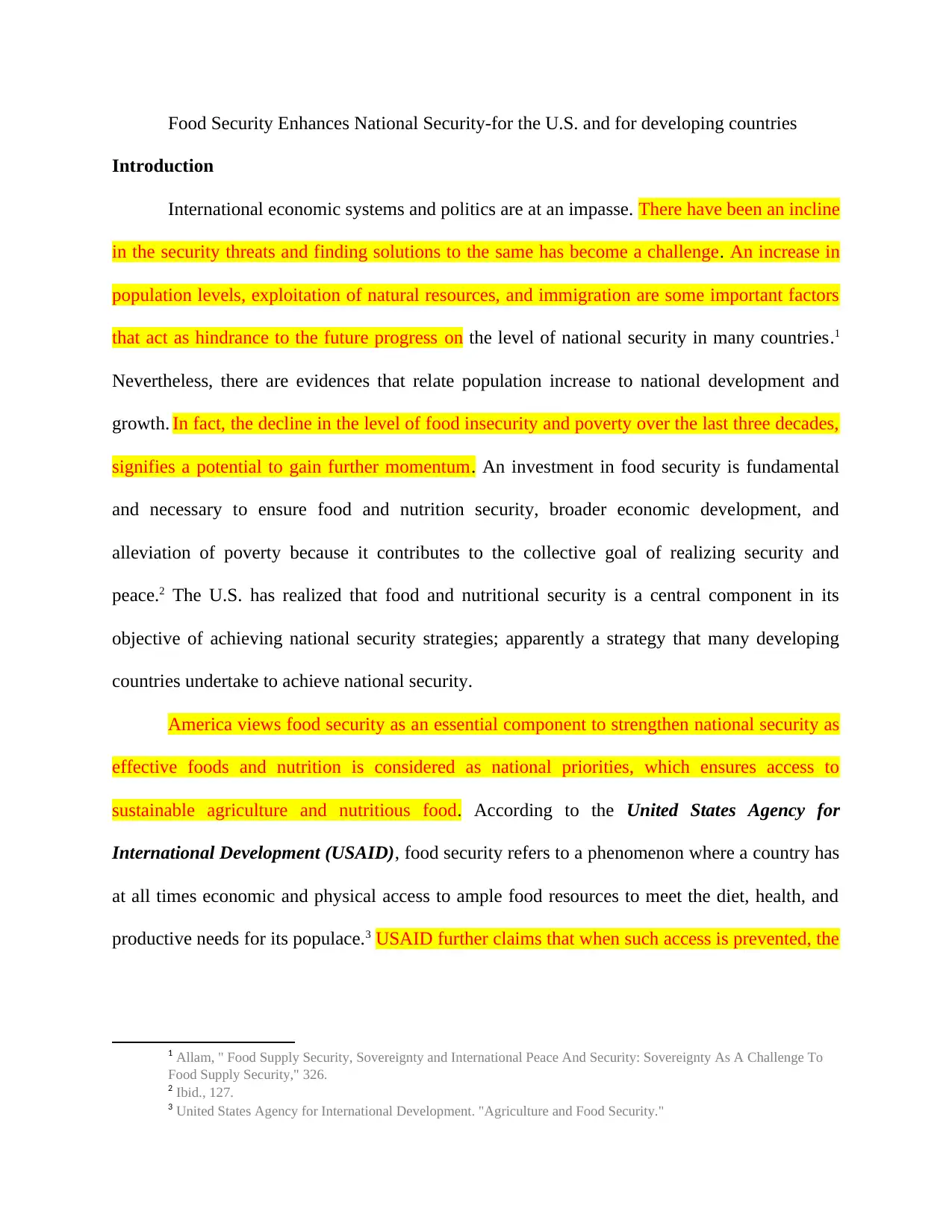
Food Security Enhances National Security-for the U.S. and for developing countries
Introduction
International economic systems and politics are at an impasse. There have been an incline
in the security threats and finding solutions to the same has become a challenge. An increase in
population levels, exploitation of natural resources, and immigration are some important factors
that act as hindrance to the future progress on the level of national security in many countries.1
Nevertheless, there are evidences that relate population increase to national development and
growth. In fact, the decline in the level of food insecurity and poverty over the last three decades,
signifies a potential to gain further momentum. An investment in food security is fundamental
and necessary to ensure food and nutrition security, broader economic development, and
alleviation of poverty because it contributes to the collective goal of realizing security and
peace.2 The U.S. has realized that food and nutritional security is a central component in its
objective of achieving national security strategies; apparently a strategy that many developing
countries undertake to achieve national security.
America views food security as an essential component to strengthen national security as
effective foods and nutrition is considered as national priorities, which ensures access to
sustainable agriculture and nutritious food. According to the United States Agency for
International Development (USAID), food security refers to a phenomenon where a country has
at all times economic and physical access to ample food resources to meet the diet, health, and
productive needs for its populace.3 USAID further claims that when such access is prevented, the
1 Allam, " Food Supply Security, Sovereignty and International Peace And Security: Sovereignty As A Challenge To
Food Supply Security," 326.
2 Ibid., 127.
3 United States Agency for International Development. "Agriculture and Food Security."
Introduction
International economic systems and politics are at an impasse. There have been an incline
in the security threats and finding solutions to the same has become a challenge. An increase in
population levels, exploitation of natural resources, and immigration are some important factors
that act as hindrance to the future progress on the level of national security in many countries.1
Nevertheless, there are evidences that relate population increase to national development and
growth. In fact, the decline in the level of food insecurity and poverty over the last three decades,
signifies a potential to gain further momentum. An investment in food security is fundamental
and necessary to ensure food and nutrition security, broader economic development, and
alleviation of poverty because it contributes to the collective goal of realizing security and
peace.2 The U.S. has realized that food and nutritional security is a central component in its
objective of achieving national security strategies; apparently a strategy that many developing
countries undertake to achieve national security.
America views food security as an essential component to strengthen national security as
effective foods and nutrition is considered as national priorities, which ensures access to
sustainable agriculture and nutritious food. According to the United States Agency for
International Development (USAID), food security refers to a phenomenon where a country has
at all times economic and physical access to ample food resources to meet the diet, health, and
productive needs for its populace.3 USAID further claims that when such access is prevented, the
1 Allam, " Food Supply Security, Sovereignty and International Peace And Security: Sovereignty As A Challenge To
Food Supply Security," 326.
2 Ibid., 127.
3 United States Agency for International Development. "Agriculture and Food Security."
Paraphrase This Document
Need a fresh take? Get an instant paraphrase of this document with our AI Paraphraser
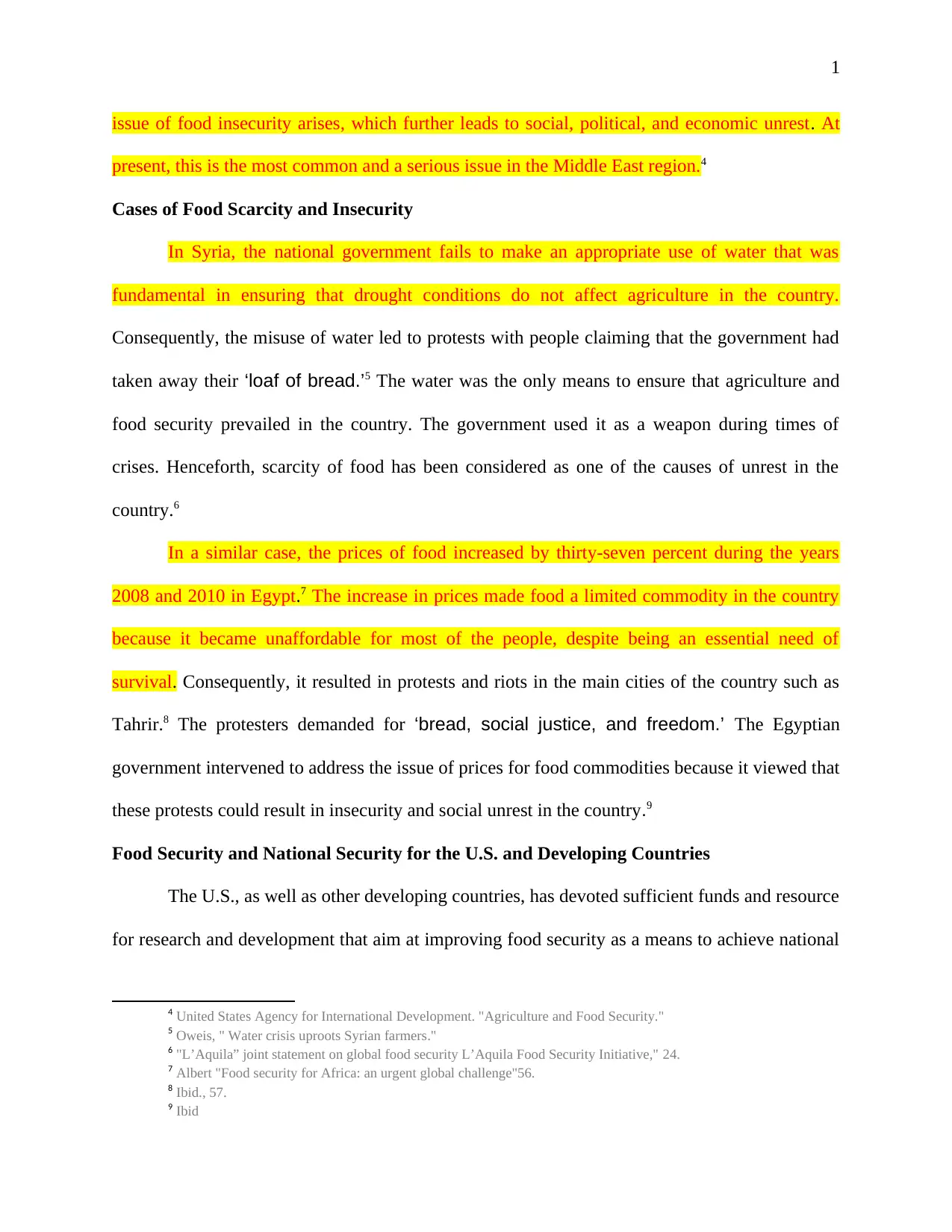
1
issue of food insecurity arises, which further leads to social, political, and economic unrest. At
present, this is the most common and a serious issue in the Middle East region.4
Cases of Food Scarcity and Insecurity
In Syria, the national government fails to make an appropriate use of water that was
fundamental in ensuring that drought conditions do not affect agriculture in the country.
Consequently, the misuse of water led to protests with people claiming that the government had
taken away their ‘loaf of bread.’5 The water was the only means to ensure that agriculture and
food security prevailed in the country. The government used it as a weapon during times of
crises. Henceforth, scarcity of food has been considered as one of the causes of unrest in the
country.6
In a similar case, the prices of food increased by thirty-seven percent during the years
2008 and 2010 in Egypt.7 The increase in prices made food a limited commodity in the country
because it became unaffordable for most of the people, despite being an essential need of
survival. Consequently, it resulted in protests and riots in the main cities of the country such as
Tahrir.8 The protesters demanded for ‘bread, social justice, and freedom.’ The Egyptian
government intervened to address the issue of prices for food commodities because it viewed that
these protests could result in insecurity and social unrest in the country.9
Food Security and National Security for the U.S. and Developing Countries
The U.S., as well as other developing countries, has devoted sufficient funds and resource
for research and development that aim at improving food security as a means to achieve national
4 United States Agency for International Development. "Agriculture and Food Security."
5 Oweis, " Water crisis uproots Syrian farmers."
6 "L’Aquila” joint statement on global food security L’Aquila Food Security Initiative," 24.
7 Albert "Food security for Africa: an urgent global challenge"56.
8 Ibid., 57.
9 Ibid
issue of food insecurity arises, which further leads to social, political, and economic unrest. At
present, this is the most common and a serious issue in the Middle East region.4
Cases of Food Scarcity and Insecurity
In Syria, the national government fails to make an appropriate use of water that was
fundamental in ensuring that drought conditions do not affect agriculture in the country.
Consequently, the misuse of water led to protests with people claiming that the government had
taken away their ‘loaf of bread.’5 The water was the only means to ensure that agriculture and
food security prevailed in the country. The government used it as a weapon during times of
crises. Henceforth, scarcity of food has been considered as one of the causes of unrest in the
country.6
In a similar case, the prices of food increased by thirty-seven percent during the years
2008 and 2010 in Egypt.7 The increase in prices made food a limited commodity in the country
because it became unaffordable for most of the people, despite being an essential need of
survival. Consequently, it resulted in protests and riots in the main cities of the country such as
Tahrir.8 The protesters demanded for ‘bread, social justice, and freedom.’ The Egyptian
government intervened to address the issue of prices for food commodities because it viewed that
these protests could result in insecurity and social unrest in the country.9
Food Security and National Security for the U.S. and Developing Countries
The U.S., as well as other developing countries, has devoted sufficient funds and resource
for research and development that aim at improving food security as a means to achieve national
4 United States Agency for International Development. "Agriculture and Food Security."
5 Oweis, " Water crisis uproots Syrian farmers."
6 "L’Aquila” joint statement on global food security L’Aquila Food Security Initiative," 24.
7 Albert "Food security for Africa: an urgent global challenge"56.
8 Ibid., 57.
9 Ibid
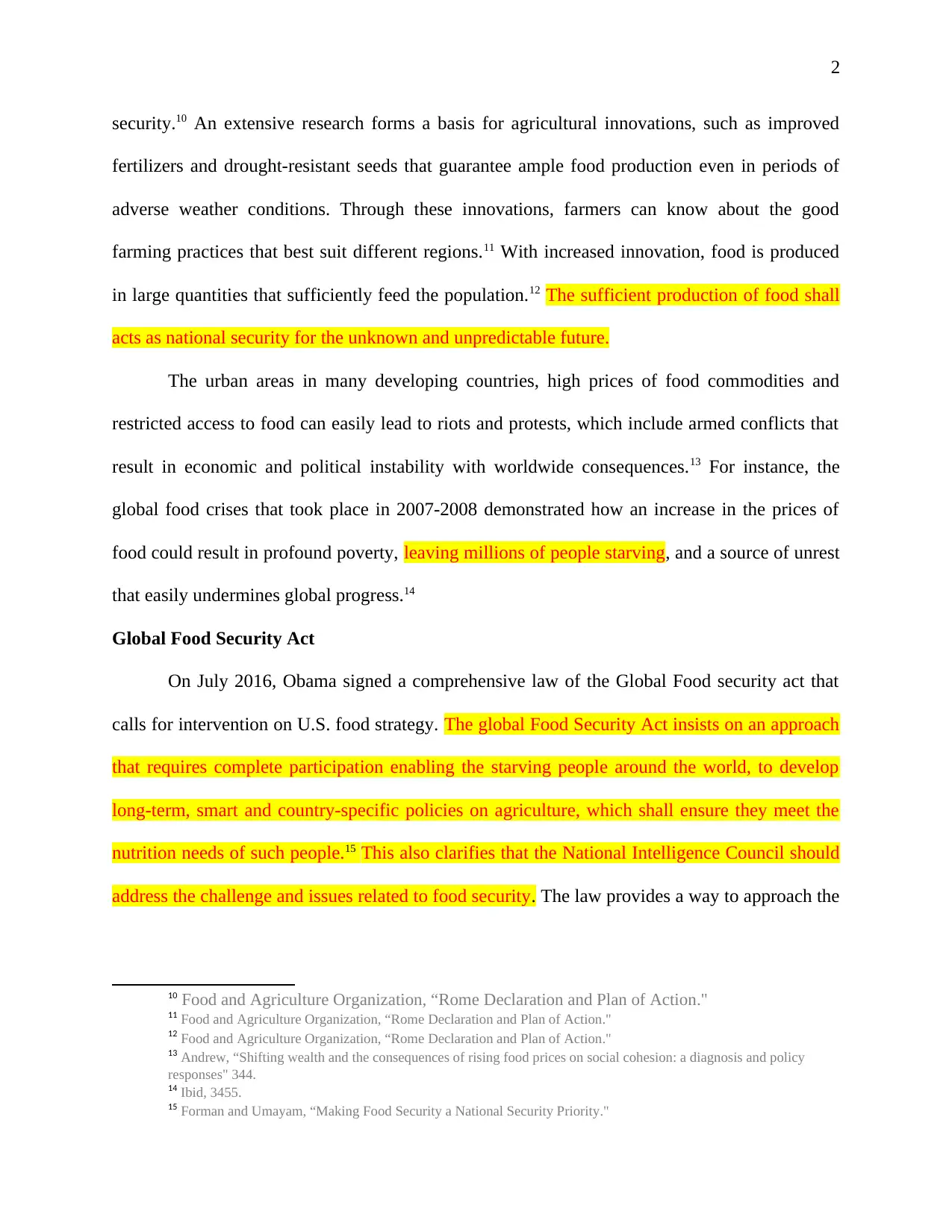
2
security.10 An extensive research forms a basis for agricultural innovations, such as improved
fertilizers and drought-resistant seeds that guarantee ample food production even in periods of
adverse weather conditions. Through these innovations, farmers can know about the good
farming practices that best suit different regions.11 With increased innovation, food is produced
in large quantities that sufficiently feed the population.12 The sufficient production of food shall
acts as national security for the unknown and unpredictable future.
The urban areas in many developing countries, high prices of food commodities and
restricted access to food can easily lead to riots and protests, which include armed conflicts that
result in economic and political instability with worldwide consequences.13 For instance, the
global food crises that took place in 2007-2008 demonstrated how an increase in the prices of
food could result in profound poverty, leaving millions of people starving, and a source of unrest
that easily undermines global progress.14
Global Food Security Act
On July 2016, Obama signed a comprehensive law of the Global Food security act that
calls for intervention on U.S. food strategy. The global Food Security Act insists on an approach
that requires complete participation enabling the starving people around the world, to develop
long-term, smart and country-specific policies on agriculture, which shall ensure they meet the
nutrition needs of such people.15 This also clarifies that the National Intelligence Council should
address the challenge and issues related to food security. The law provides a way to approach the
10 Food and Agriculture Organization, “Rome Declaration and Plan of Action."
11 Food and Agriculture Organization, “Rome Declaration and Plan of Action."
12 Food and Agriculture Organization, “Rome Declaration and Plan of Action."
13 Andrew, “Shifting wealth and the consequences of rising food prices on social cohesion: a diagnosis and policy
responses" 344.
14 Ibid, 3455.
15 Forman and Umayam, “Making Food Security a National Security Priority."
security.10 An extensive research forms a basis for agricultural innovations, such as improved
fertilizers and drought-resistant seeds that guarantee ample food production even in periods of
adverse weather conditions. Through these innovations, farmers can know about the good
farming practices that best suit different regions.11 With increased innovation, food is produced
in large quantities that sufficiently feed the population.12 The sufficient production of food shall
acts as national security for the unknown and unpredictable future.
The urban areas in many developing countries, high prices of food commodities and
restricted access to food can easily lead to riots and protests, which include armed conflicts that
result in economic and political instability with worldwide consequences.13 For instance, the
global food crises that took place in 2007-2008 demonstrated how an increase in the prices of
food could result in profound poverty, leaving millions of people starving, and a source of unrest
that easily undermines global progress.14
Global Food Security Act
On July 2016, Obama signed a comprehensive law of the Global Food security act that
calls for intervention on U.S. food strategy. The global Food Security Act insists on an approach
that requires complete participation enabling the starving people around the world, to develop
long-term, smart and country-specific policies on agriculture, which shall ensure they meet the
nutrition needs of such people.15 This also clarifies that the National Intelligence Council should
address the challenge and issues related to food security. The law provides a way to approach the
10 Food and Agriculture Organization, “Rome Declaration and Plan of Action."
11 Food and Agriculture Organization, “Rome Declaration and Plan of Action."
12 Food and Agriculture Organization, “Rome Declaration and Plan of Action."
13 Andrew, “Shifting wealth and the consequences of rising food prices on social cohesion: a diagnosis and policy
responses" 344.
14 Ibid, 3455.
15 Forman and Umayam, “Making Food Security a National Security Priority."
⊘ This is a preview!⊘
Do you want full access?
Subscribe today to unlock all pages.

Trusted by 1+ million students worldwide
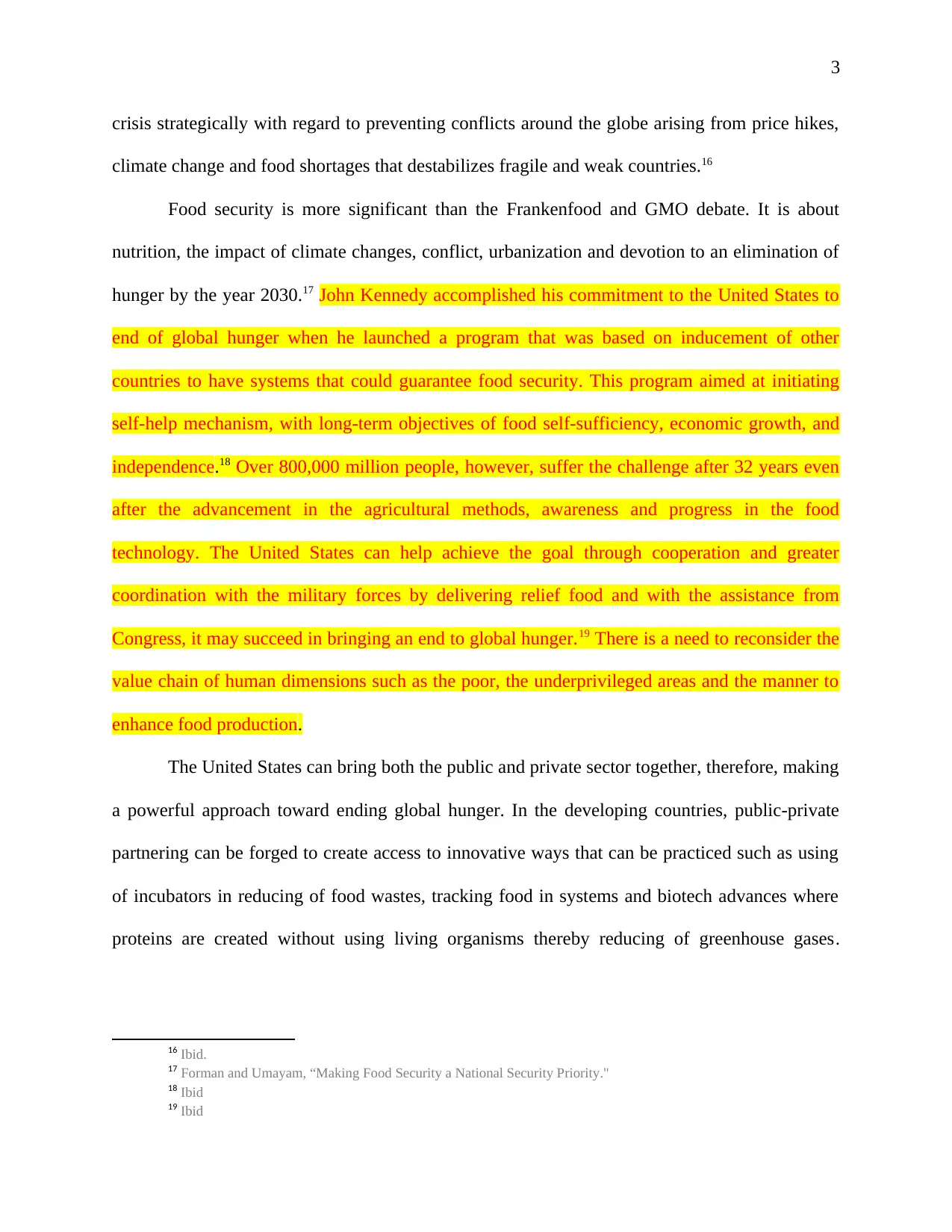
3
crisis strategically with regard to preventing conflicts around the globe arising from price hikes,
climate change and food shortages that destabilizes fragile and weak countries.16
Food security is more significant than the Frankenfood and GMO debate. It is about
nutrition, the impact of climate changes, conflict, urbanization and devotion to an elimination of
hunger by the year 2030.17 John Kennedy accomplished his commitment to the United States to
end of global hunger when he launched a program that was based on inducement of other
countries to have systems that could guarantee food security. This program aimed at initiating
self-help mechanism, with long-term objectives of food self-sufficiency, economic growth, and
independence.18 Over 800,000 million people, however, suffer the challenge after 32 years even
after the advancement in the agricultural methods, awareness and progress in the food
technology. The United States can help achieve the goal through cooperation and greater
coordination with the military forces by delivering relief food and with the assistance from
Congress, it may succeed in bringing an end to global hunger.19 There is a need to reconsider the
value chain of human dimensions such as the poor, the underprivileged areas and the manner to
enhance food production.
The United States can bring both the public and private sector together, therefore, making
a powerful approach toward ending global hunger. In the developing countries, public-private
partnering can be forged to create access to innovative ways that can be practiced such as using
of incubators in reducing of food wastes, tracking food in systems and biotech advances where
proteins are created without using living organisms thereby reducing of greenhouse gases.
16 Ibid.
17 Forman and Umayam, “Making Food Security a National Security Priority."
18 Ibid
19 Ibid
crisis strategically with regard to preventing conflicts around the globe arising from price hikes,
climate change and food shortages that destabilizes fragile and weak countries.16
Food security is more significant than the Frankenfood and GMO debate. It is about
nutrition, the impact of climate changes, conflict, urbanization and devotion to an elimination of
hunger by the year 2030.17 John Kennedy accomplished his commitment to the United States to
end of global hunger when he launched a program that was based on inducement of other
countries to have systems that could guarantee food security. This program aimed at initiating
self-help mechanism, with long-term objectives of food self-sufficiency, economic growth, and
independence.18 Over 800,000 million people, however, suffer the challenge after 32 years even
after the advancement in the agricultural methods, awareness and progress in the food
technology. The United States can help achieve the goal through cooperation and greater
coordination with the military forces by delivering relief food and with the assistance from
Congress, it may succeed in bringing an end to global hunger.19 There is a need to reconsider the
value chain of human dimensions such as the poor, the underprivileged areas and the manner to
enhance food production.
The United States can bring both the public and private sector together, therefore, making
a powerful approach toward ending global hunger. In the developing countries, public-private
partnering can be forged to create access to innovative ways that can be practiced such as using
of incubators in reducing of food wastes, tracking food in systems and biotech advances where
proteins are created without using living organisms thereby reducing of greenhouse gases.
16 Ibid.
17 Forman and Umayam, “Making Food Security a National Security Priority."
18 Ibid
19 Ibid
Paraphrase This Document
Need a fresh take? Get an instant paraphrase of this document with our AI Paraphraser
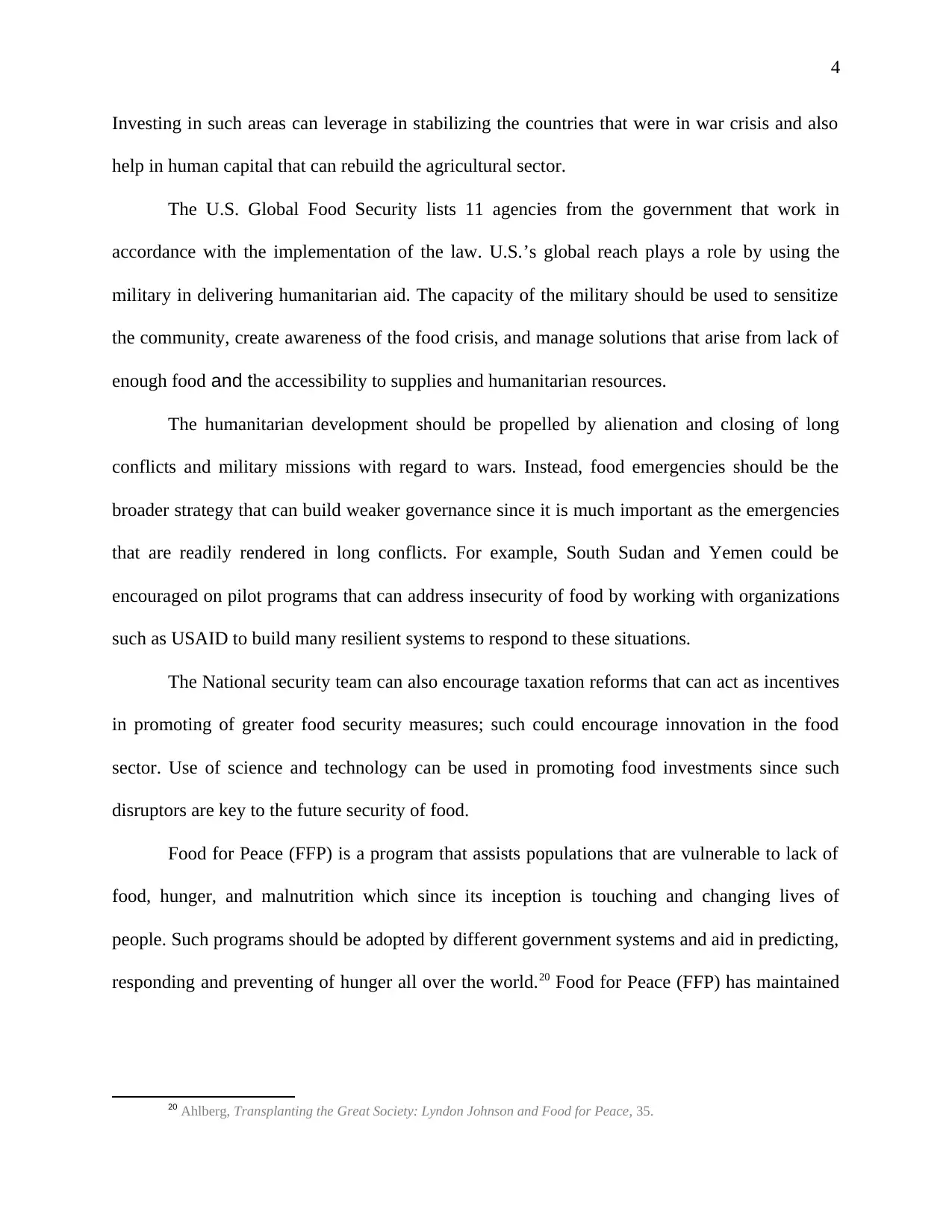
4
Investing in such areas can leverage in stabilizing the countries that were in war crisis and also
help in human capital that can rebuild the agricultural sector.
The U.S. Global Food Security lists 11 agencies from the government that work in
accordance with the implementation of the law. U.S.’s global reach plays a role by using the
military in delivering humanitarian aid. The capacity of the military should be used to sensitize
the community, create awareness of the food crisis, and manage solutions that arise from lack of
enough food and the accessibility to supplies and humanitarian resources.
The humanitarian development should be propelled by alienation and closing of long
conflicts and military missions with regard to wars. Instead, food emergencies should be the
broader strategy that can build weaker governance since it is much important as the emergencies
that are readily rendered in long conflicts. For example, South Sudan and Yemen could be
encouraged on pilot programs that can address insecurity of food by working with organizations
such as USAID to build many resilient systems to respond to these situations.
The National security team can also encourage taxation reforms that can act as incentives
in promoting of greater food security measures; such could encourage innovation in the food
sector. Use of science and technology can be used in promoting food investments since such
disruptors are key to the future security of food.
Food for Peace (FFP) is a program that assists populations that are vulnerable to lack of
food, hunger, and malnutrition which since its inception is touching and changing lives of
people. Such programs should be adopted by different government systems and aid in predicting,
responding and preventing of hunger all over the world.20 Food for Peace (FFP) has maintained
20 Ahlberg, Transplanting the Great Society: Lyndon Johnson and Food for Peace, 35.
Investing in such areas can leverage in stabilizing the countries that were in war crisis and also
help in human capital that can rebuild the agricultural sector.
The U.S. Global Food Security lists 11 agencies from the government that work in
accordance with the implementation of the law. U.S.’s global reach plays a role by using the
military in delivering humanitarian aid. The capacity of the military should be used to sensitize
the community, create awareness of the food crisis, and manage solutions that arise from lack of
enough food and the accessibility to supplies and humanitarian resources.
The humanitarian development should be propelled by alienation and closing of long
conflicts and military missions with regard to wars. Instead, food emergencies should be the
broader strategy that can build weaker governance since it is much important as the emergencies
that are readily rendered in long conflicts. For example, South Sudan and Yemen could be
encouraged on pilot programs that can address insecurity of food by working with organizations
such as USAID to build many resilient systems to respond to these situations.
The National security team can also encourage taxation reforms that can act as incentives
in promoting of greater food security measures; such could encourage innovation in the food
sector. Use of science and technology can be used in promoting food investments since such
disruptors are key to the future security of food.
Food for Peace (FFP) is a program that assists populations that are vulnerable to lack of
food, hunger, and malnutrition which since its inception is touching and changing lives of
people. Such programs should be adopted by different government systems and aid in predicting,
responding and preventing of hunger all over the world.20 Food for Peace (FFP) has maintained
20 Ahlberg, Transplanting the Great Society: Lyndon Johnson and Food for Peace, 35.
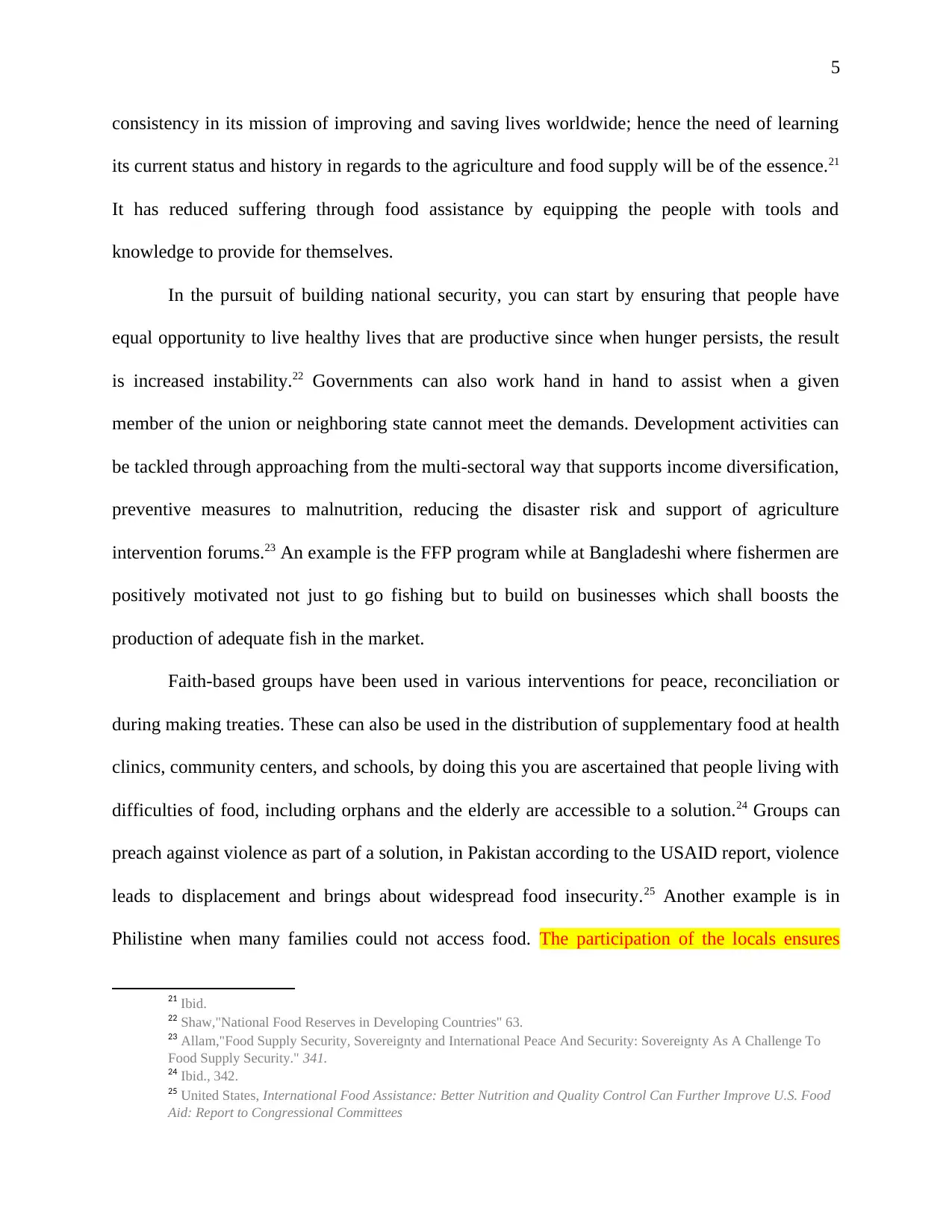
5
consistency in its mission of improving and saving lives worldwide; hence the need of learning
its current status and history in regards to the agriculture and food supply will be of the essence.21
It has reduced suffering through food assistance by equipping the people with tools and
knowledge to provide for themselves.
In the pursuit of building national security, you can start by ensuring that people have
equal opportunity to live healthy lives that are productive since when hunger persists, the result
is increased instability.22 Governments can also work hand in hand to assist when a given
member of the union or neighboring state cannot meet the demands. Development activities can
be tackled through approaching from the multi-sectoral way that supports income diversification,
preventive measures to malnutrition, reducing the disaster risk and support of agriculture
intervention forums.23 An example is the FFP program while at Bangladeshi where fishermen are
positively motivated not just to go fishing but to build on businesses which shall boosts the
production of adequate fish in the market.
Faith-based groups have been used in various interventions for peace, reconciliation or
during making treaties. These can also be used in the distribution of supplementary food at health
clinics, community centers, and schools, by doing this you are ascertained that people living with
difficulties of food, including orphans and the elderly are accessible to a solution.24 Groups can
preach against violence as part of a solution, in Pakistan according to the USAID report, violence
leads to displacement and brings about widespread food insecurity.25 Another example is in
Philistine when many families could not access food. The participation of the locals ensures
21 Ibid.
22 Shaw,"National Food Reserves in Developing Countries" 63.
23 Allam,"Food Supply Security, Sovereignty and International Peace And Security: Sovereignty As A Challenge To
Food Supply Security." 341.
24 Ibid., 342.
25 United States, International Food Assistance: Better Nutrition and Quality Control Can Further Improve U.S. Food
Aid: Report to Congressional Committees
consistency in its mission of improving and saving lives worldwide; hence the need of learning
its current status and history in regards to the agriculture and food supply will be of the essence.21
It has reduced suffering through food assistance by equipping the people with tools and
knowledge to provide for themselves.
In the pursuit of building national security, you can start by ensuring that people have
equal opportunity to live healthy lives that are productive since when hunger persists, the result
is increased instability.22 Governments can also work hand in hand to assist when a given
member of the union or neighboring state cannot meet the demands. Development activities can
be tackled through approaching from the multi-sectoral way that supports income diversification,
preventive measures to malnutrition, reducing the disaster risk and support of agriculture
intervention forums.23 An example is the FFP program while at Bangladeshi where fishermen are
positively motivated not just to go fishing but to build on businesses which shall boosts the
production of adequate fish in the market.
Faith-based groups have been used in various interventions for peace, reconciliation or
during making treaties. These can also be used in the distribution of supplementary food at health
clinics, community centers, and schools, by doing this you are ascertained that people living with
difficulties of food, including orphans and the elderly are accessible to a solution.24 Groups can
preach against violence as part of a solution, in Pakistan according to the USAID report, violence
leads to displacement and brings about widespread food insecurity.25 Another example is in
Philistine when many families could not access food. The participation of the locals ensures
21 Ibid.
22 Shaw,"National Food Reserves in Developing Countries" 63.
23 Allam,"Food Supply Security, Sovereignty and International Peace And Security: Sovereignty As A Challenge To
Food Supply Security." 341.
24 Ibid., 342.
25 United States, International Food Assistance: Better Nutrition and Quality Control Can Further Improve U.S. Food
Aid: Report to Congressional Committees
⊘ This is a preview!⊘
Do you want full access?
Subscribe today to unlock all pages.

Trusted by 1+ million students worldwide
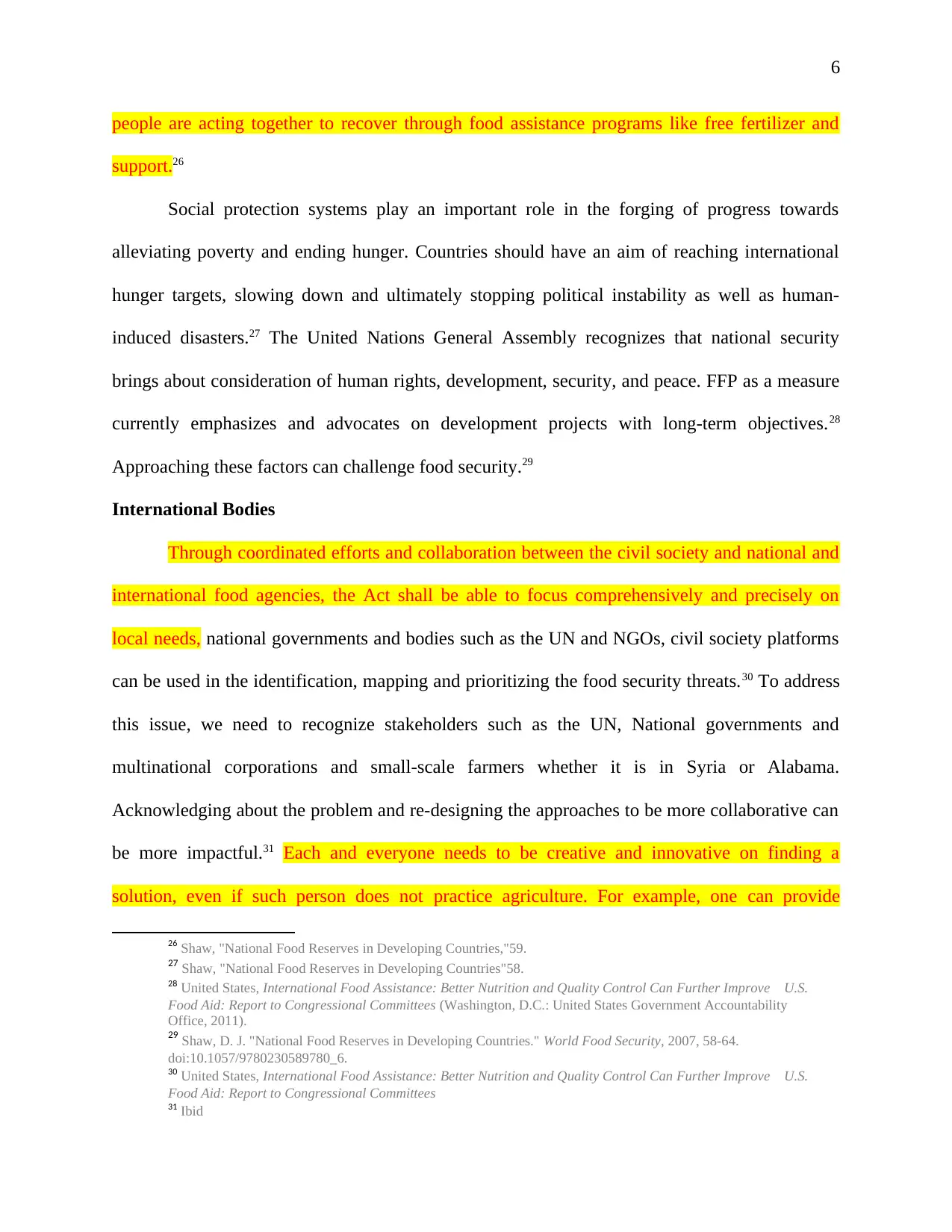
6
people are acting together to recover through food assistance programs like free fertilizer and
support.26
Social protection systems play an important role in the forging of progress towards
alleviating poverty and ending hunger. Countries should have an aim of reaching international
hunger targets, slowing down and ultimately stopping political instability as well as human-
induced disasters.27 The United Nations General Assembly recognizes that national security
brings about consideration of human rights, development, security, and peace. FFP as a measure
currently emphasizes and advocates on development projects with long-term objectives.28
Approaching these factors can challenge food security.29
International Bodies
Through coordinated efforts and collaboration between the civil society and national and
international food agencies, the Act shall be able to focus comprehensively and precisely on
local needs, national governments and bodies such as the UN and NGOs, civil society platforms
can be used in the identification, mapping and prioritizing the food security threats.30 To address
this issue, we need to recognize stakeholders such as the UN, National governments and
multinational corporations and small-scale farmers whether it is in Syria or Alabama.
Acknowledging about the problem and re-designing the approaches to be more collaborative can
be more impactful.31 Each and everyone needs to be creative and innovative on finding a
solution, even if such person does not practice agriculture. For example, one can provide
26 Shaw, "National Food Reserves in Developing Countries,"59.
27 Shaw, "National Food Reserves in Developing Countries"58.
28 United States, International Food Assistance: Better Nutrition and Quality Control Can Further Improve U.S.
Food Aid: Report to Congressional Committees (Washington, D.C.: United States Government Accountability
Office, 2011).
29 Shaw, D. J. "National Food Reserves in Developing Countries." World Food Security, 2007, 58-64.
doi:10.1057/9780230589780_6.
30 United States, International Food Assistance: Better Nutrition and Quality Control Can Further Improve U.S.
Food Aid: Report to Congressional Committees
31 Ibid
people are acting together to recover through food assistance programs like free fertilizer and
support.26
Social protection systems play an important role in the forging of progress towards
alleviating poverty and ending hunger. Countries should have an aim of reaching international
hunger targets, slowing down and ultimately stopping political instability as well as human-
induced disasters.27 The United Nations General Assembly recognizes that national security
brings about consideration of human rights, development, security, and peace. FFP as a measure
currently emphasizes and advocates on development projects with long-term objectives.28
Approaching these factors can challenge food security.29
International Bodies
Through coordinated efforts and collaboration between the civil society and national and
international food agencies, the Act shall be able to focus comprehensively and precisely on
local needs, national governments and bodies such as the UN and NGOs, civil society platforms
can be used in the identification, mapping and prioritizing the food security threats.30 To address
this issue, we need to recognize stakeholders such as the UN, National governments and
multinational corporations and small-scale farmers whether it is in Syria or Alabama.
Acknowledging about the problem and re-designing the approaches to be more collaborative can
be more impactful.31 Each and everyone needs to be creative and innovative on finding a
solution, even if such person does not practice agriculture. For example, one can provide
26 Shaw, "National Food Reserves in Developing Countries,"59.
27 Shaw, "National Food Reserves in Developing Countries"58.
28 United States, International Food Assistance: Better Nutrition and Quality Control Can Further Improve U.S.
Food Aid: Report to Congressional Committees (Washington, D.C.: United States Government Accountability
Office, 2011).
29 Shaw, D. J. "National Food Reserves in Developing Countries." World Food Security, 2007, 58-64.
doi:10.1057/9780230589780_6.
30 United States, International Food Assistance: Better Nutrition and Quality Control Can Further Improve U.S.
Food Aid: Report to Congressional Committees
31 Ibid
Paraphrase This Document
Need a fresh take? Get an instant paraphrase of this document with our AI Paraphraser
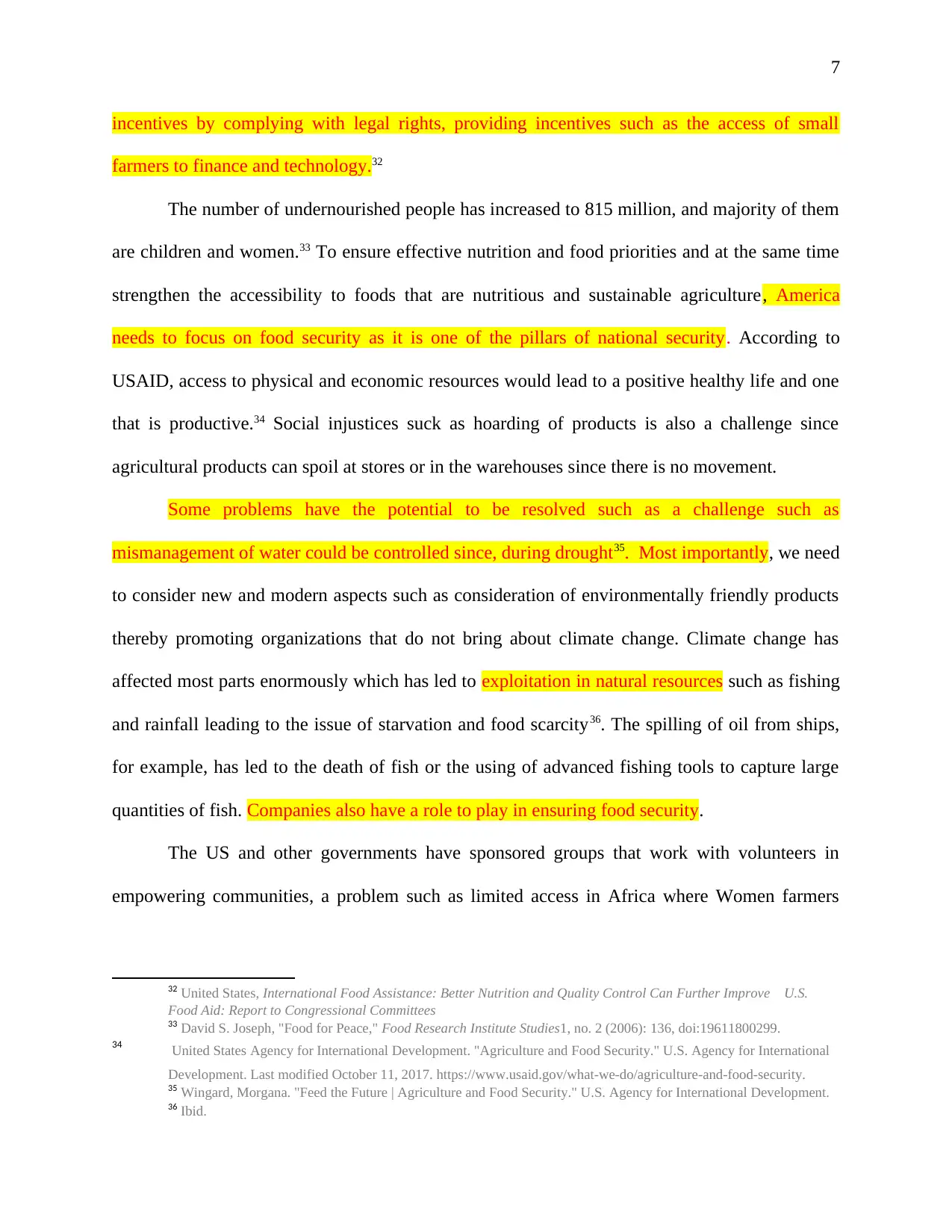
7
incentives by complying with legal rights, providing incentives such as the access of small
farmers to finance and technology.32
The number of undernourished people has increased to 815 million, and majority of them
are children and women.33 To ensure effective nutrition and food priorities and at the same time
strengthen the accessibility to foods that are nutritious and sustainable agriculture, America
needs to focus on food security as it is one of the pillars of national security. According to
USAID, access to physical and economic resources would lead to a positive healthy life and one
that is productive.34 Social injustices suck as hoarding of products is also a challenge since
agricultural products can spoil at stores or in the warehouses since there is no movement.
Some problems have the potential to be resolved such as a challenge such as
mismanagement of water could be controlled since, during drought35. Most importantly, we need
to consider new and modern aspects such as consideration of environmentally friendly products
thereby promoting organizations that do not bring about climate change. Climate change has
affected most parts enormously which has led to exploitation in natural resources such as fishing
and rainfall leading to the issue of starvation and food scarcity36. The spilling of oil from ships,
for example, has led to the death of fish or the using of advanced fishing tools to capture large
quantities of fish. Companies also have a role to play in ensuring food security.
The US and other governments have sponsored groups that work with volunteers in
empowering communities, a problem such as limited access in Africa where Women farmers
32 United States, International Food Assistance: Better Nutrition and Quality Control Can Further Improve U.S.
Food Aid: Report to Congressional Committees
33 David S. Joseph, "Food for Peace," Food Research Institute Studies1, no. 2 (2006): 136, doi:19611800299.
34 United States Agency for International Development. "Agriculture and Food Security." U.S. Agency for International
Development. Last modified October 11, 2017. https://www.usaid.gov/what-we-do/agriculture-and-food-security.
35 Wingard, Morgana. "Feed the Future | Agriculture and Food Security." U.S. Agency for International Development.
36 Ibid.
incentives by complying with legal rights, providing incentives such as the access of small
farmers to finance and technology.32
The number of undernourished people has increased to 815 million, and majority of them
are children and women.33 To ensure effective nutrition and food priorities and at the same time
strengthen the accessibility to foods that are nutritious and sustainable agriculture, America
needs to focus on food security as it is one of the pillars of national security. According to
USAID, access to physical and economic resources would lead to a positive healthy life and one
that is productive.34 Social injustices suck as hoarding of products is also a challenge since
agricultural products can spoil at stores or in the warehouses since there is no movement.
Some problems have the potential to be resolved such as a challenge such as
mismanagement of water could be controlled since, during drought35. Most importantly, we need
to consider new and modern aspects such as consideration of environmentally friendly products
thereby promoting organizations that do not bring about climate change. Climate change has
affected most parts enormously which has led to exploitation in natural resources such as fishing
and rainfall leading to the issue of starvation and food scarcity36. The spilling of oil from ships,
for example, has led to the death of fish or the using of advanced fishing tools to capture large
quantities of fish. Companies also have a role to play in ensuring food security.
The US and other governments have sponsored groups that work with volunteers in
empowering communities, a problem such as limited access in Africa where Women farmers
32 United States, International Food Assistance: Better Nutrition and Quality Control Can Further Improve U.S.
Food Aid: Report to Congressional Committees
33 David S. Joseph, "Food for Peace," Food Research Institute Studies1, no. 2 (2006): 136, doi:19611800299.
34 United States Agency for International Development. "Agriculture and Food Security." U.S. Agency for International
Development. Last modified October 11, 2017. https://www.usaid.gov/what-we-do/agriculture-and-food-security.
35 Wingard, Morgana. "Feed the Future | Agriculture and Food Security." U.S. Agency for International Development.
36 Ibid.
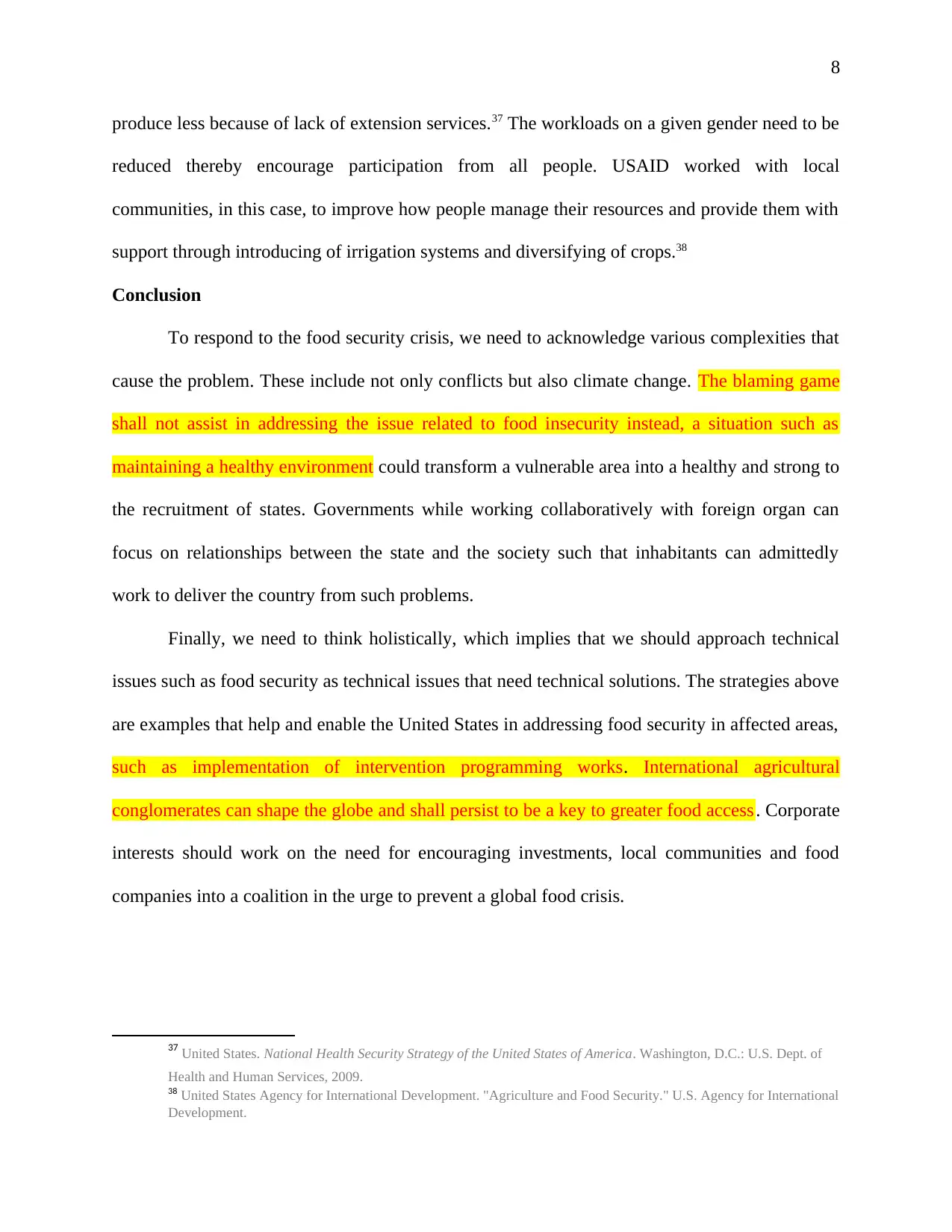
8
produce less because of lack of extension services.37 The workloads on a given gender need to be
reduced thereby encourage participation from all people. USAID worked with local
communities, in this case, to improve how people manage their resources and provide them with
support through introducing of irrigation systems and diversifying of crops.38
Conclusion
To respond to the food security crisis, we need to acknowledge various complexities that
cause the problem. These include not only conflicts but also climate change. The blaming game
shall not assist in addressing the issue related to food insecurity instead, a situation such as
maintaining a healthy environment could transform a vulnerable area into a healthy and strong to
the recruitment of states. Governments while working collaboratively with foreign organ can
focus on relationships between the state and the society such that inhabitants can admittedly
work to deliver the country from such problems.
Finally, we need to think holistically, which implies that we should approach technical
issues such as food security as technical issues that need technical solutions. The strategies above
are examples that help and enable the United States in addressing food security in affected areas,
such as implementation of intervention programming works. International agricultural
conglomerates can shape the globe and shall persist to be a key to greater food access. Corporate
interests should work on the need for encouraging investments, local communities and food
companies into a coalition in the urge to prevent a global food crisis.
37 United States. National Health Security Strategy of the United States of America. Washington, D.C.: U.S. Dept. of
Health and Human Services, 2009.
38 United States Agency for International Development. "Agriculture and Food Security." U.S. Agency for International
Development.
produce less because of lack of extension services.37 The workloads on a given gender need to be
reduced thereby encourage participation from all people. USAID worked with local
communities, in this case, to improve how people manage their resources and provide them with
support through introducing of irrigation systems and diversifying of crops.38
Conclusion
To respond to the food security crisis, we need to acknowledge various complexities that
cause the problem. These include not only conflicts but also climate change. The blaming game
shall not assist in addressing the issue related to food insecurity instead, a situation such as
maintaining a healthy environment could transform a vulnerable area into a healthy and strong to
the recruitment of states. Governments while working collaboratively with foreign organ can
focus on relationships between the state and the society such that inhabitants can admittedly
work to deliver the country from such problems.
Finally, we need to think holistically, which implies that we should approach technical
issues such as food security as technical issues that need technical solutions. The strategies above
are examples that help and enable the United States in addressing food security in affected areas,
such as implementation of intervention programming works. International agricultural
conglomerates can shape the globe and shall persist to be a key to greater food access. Corporate
interests should work on the need for encouraging investments, local communities and food
companies into a coalition in the urge to prevent a global food crisis.
37 United States. National Health Security Strategy of the United States of America. Washington, D.C.: U.S. Dept. of
Health and Human Services, 2009.
38 United States Agency for International Development. "Agriculture and Food Security." U.S. Agency for International
Development.
⊘ This is a preview!⊘
Do you want full access?
Subscribe today to unlock all pages.

Trusted by 1+ million students worldwide
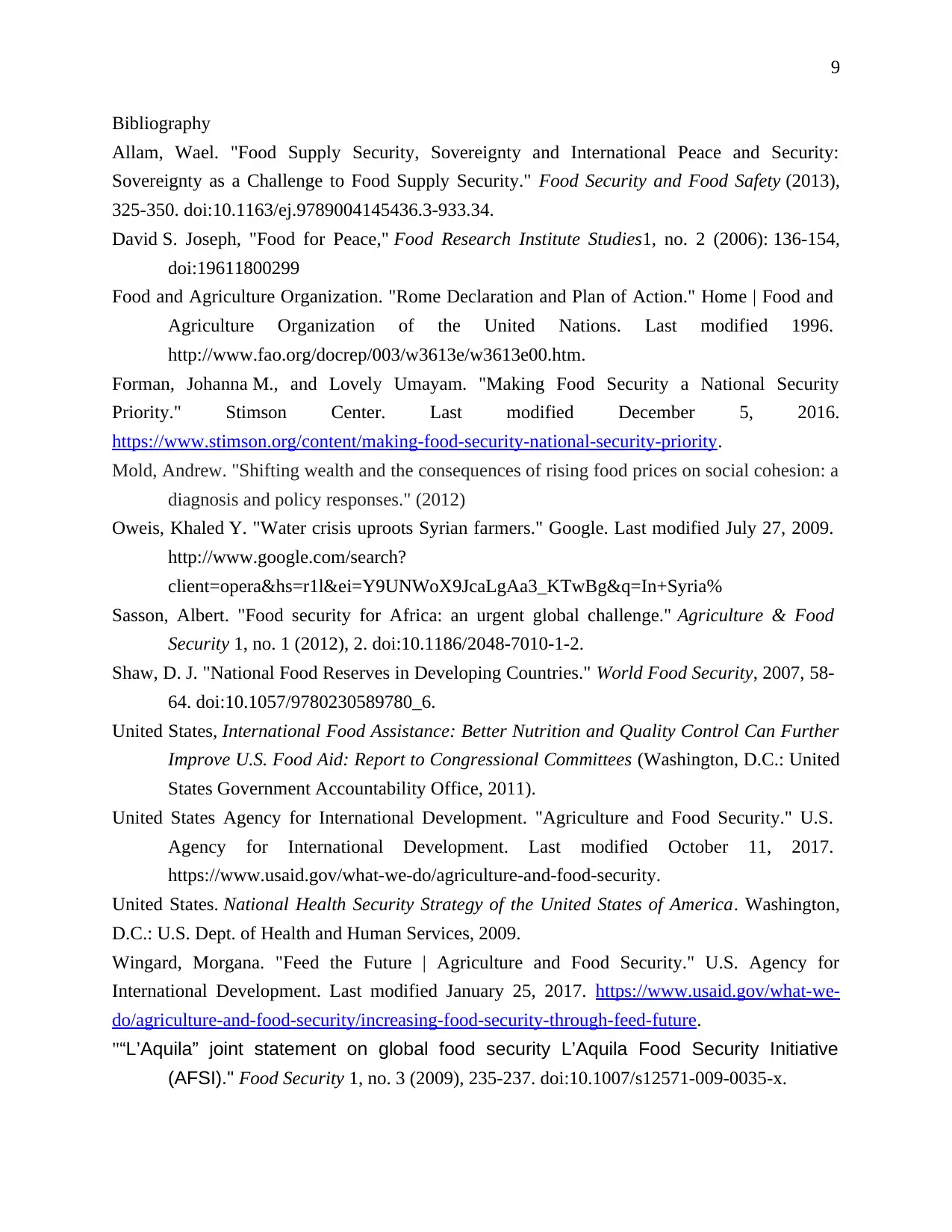
9
Bibliography
Allam, Wael. "Food Supply Security, Sovereignty and International Peace and Security:
Sovereignty as a Challenge to Food Supply Security." Food Security and Food Safety (2013),
325-350. doi:10.1163/ej.9789004145436.3-933.34.
David S. Joseph, "Food for Peace," Food Research Institute Studies1, no. 2 (2006): 136-154,
doi:19611800299
Food and Agriculture Organization. "Rome Declaration and Plan of Action." Home | Food and
Agriculture Organization of the United Nations. Last modified 1996.
http://www.fao.org/docrep/003/w3613e/w3613e00.htm.
Forman, Johanna M., and Lovely Umayam. "Making Food Security a National Security
Priority." Stimson Center. Last modified December 5, 2016.
https://www.stimson.org/content/making-food-security-national-security-priority.
Mold, Andrew. "Shifting wealth and the consequences of rising food prices on social cohesion: a
diagnosis and policy responses." (2012)
Oweis, Khaled Y. "Water crisis uproots Syrian farmers." Google. Last modified July 27, 2009.
http://www.google.com/search?
client=opera&hs=r1l&ei=Y9UNWoX9JcaLgAa3_KTwBg&q=In+Syria%
Sasson, Albert. "Food security for Africa: an urgent global challenge." Agriculture & Food
Security 1, no. 1 (2012), 2. doi:10.1186/2048-7010-1-2.
Shaw, D. J. "National Food Reserves in Developing Countries." World Food Security, 2007, 58-
64. doi:10.1057/9780230589780_6.
United States, International Food Assistance: Better Nutrition and Quality Control Can Further
Improve U.S. Food Aid: Report to Congressional Committees (Washington, D.C.: United
States Government Accountability Office, 2011).
United States Agency for International Development. "Agriculture and Food Security." U.S.
Agency for International Development. Last modified October 11, 2017.
https://www.usaid.gov/what-we-do/agriculture-and-food-security.
United States. National Health Security Strategy of the United States of America. Washington,
D.C.: U.S. Dept. of Health and Human Services, 2009.
Wingard, Morgana. "Feed the Future | Agriculture and Food Security." U.S. Agency for
International Development. Last modified January 25, 2017. https://www.usaid.gov/what-we-
do/agriculture-and-food-security/increasing-food-security-through-feed-future.
"“L’Aquila” joint statement on global food security L’Aquila Food Security Initiative
(AFSI)." Food Security 1, no. 3 (2009), 235-237. doi:10.1007/s12571-009-0035-x.
Bibliography
Allam, Wael. "Food Supply Security, Sovereignty and International Peace and Security:
Sovereignty as a Challenge to Food Supply Security." Food Security and Food Safety (2013),
325-350. doi:10.1163/ej.9789004145436.3-933.34.
David S. Joseph, "Food for Peace," Food Research Institute Studies1, no. 2 (2006): 136-154,
doi:19611800299
Food and Agriculture Organization. "Rome Declaration and Plan of Action." Home | Food and
Agriculture Organization of the United Nations. Last modified 1996.
http://www.fao.org/docrep/003/w3613e/w3613e00.htm.
Forman, Johanna M., and Lovely Umayam. "Making Food Security a National Security
Priority." Stimson Center. Last modified December 5, 2016.
https://www.stimson.org/content/making-food-security-national-security-priority.
Mold, Andrew. "Shifting wealth and the consequences of rising food prices on social cohesion: a
diagnosis and policy responses." (2012)
Oweis, Khaled Y. "Water crisis uproots Syrian farmers." Google. Last modified July 27, 2009.
http://www.google.com/search?
client=opera&hs=r1l&ei=Y9UNWoX9JcaLgAa3_KTwBg&q=In+Syria%
Sasson, Albert. "Food security for Africa: an urgent global challenge." Agriculture & Food
Security 1, no. 1 (2012), 2. doi:10.1186/2048-7010-1-2.
Shaw, D. J. "National Food Reserves in Developing Countries." World Food Security, 2007, 58-
64. doi:10.1057/9780230589780_6.
United States, International Food Assistance: Better Nutrition and Quality Control Can Further
Improve U.S. Food Aid: Report to Congressional Committees (Washington, D.C.: United
States Government Accountability Office, 2011).
United States Agency for International Development. "Agriculture and Food Security." U.S.
Agency for International Development. Last modified October 11, 2017.
https://www.usaid.gov/what-we-do/agriculture-and-food-security.
United States. National Health Security Strategy of the United States of America. Washington,
D.C.: U.S. Dept. of Health and Human Services, 2009.
Wingard, Morgana. "Feed the Future | Agriculture and Food Security." U.S. Agency for
International Development. Last modified January 25, 2017. https://www.usaid.gov/what-we-
do/agriculture-and-food-security/increasing-food-security-through-feed-future.
"“L’Aquila” joint statement on global food security L’Aquila Food Security Initiative
(AFSI)." Food Security 1, no. 3 (2009), 235-237. doi:10.1007/s12571-009-0035-x.
1 out of 10
Related Documents
Your All-in-One AI-Powered Toolkit for Academic Success.
+13062052269
info@desklib.com
Available 24*7 on WhatsApp / Email
![[object Object]](/_next/static/media/star-bottom.7253800d.svg)
Unlock your academic potential
Copyright © 2020–2025 A2Z Services. All Rights Reserved. Developed and managed by ZUCOL.





